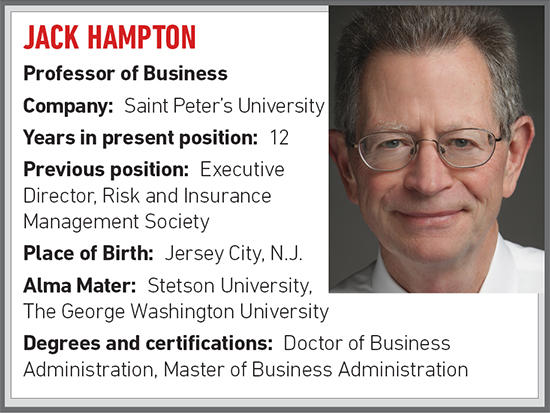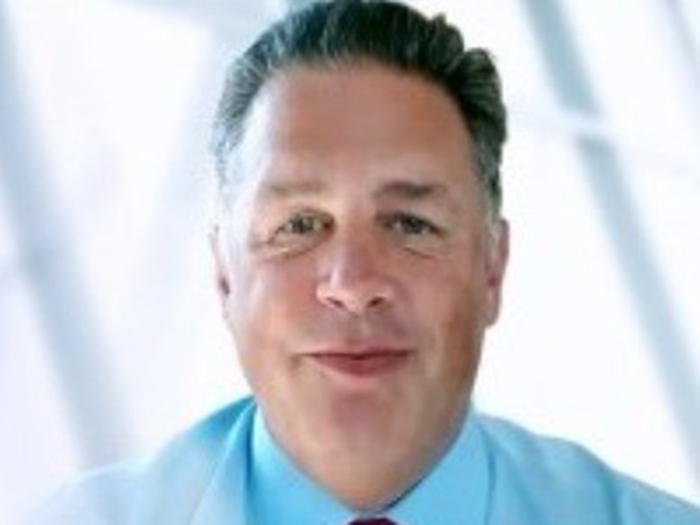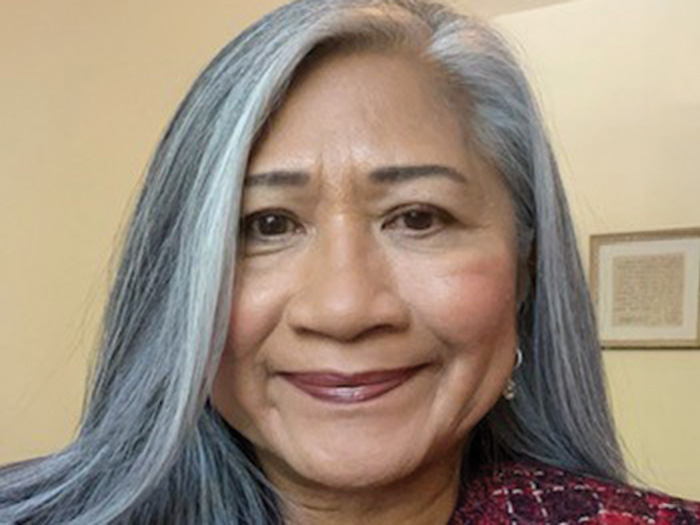The Profession
Jack Hampton of St. Peter’s University
R&I: Who is your mentor and why?
Ellen Thrower, president (retired), The College of Insurance, introduced me to the importance of insurance as a component of risk management. Further, she encouraged me to explore strategic and operational risk as foundation topics shaping the role of the modern risk manager.
Chris Mandel, former president of RIMS and Risk Manager of the Year, introduced me to the emerging area of enterprise risk management. He helped me recognize the need to align hazard, strategic, operational and financial risk into a single framework. He gave me the perspective of ERM in a high-tech environment, using USAA as a model program that later won an excellence award for innovation.
Bob Morrell, founder and former CEO of Riskonnect, showed me how technology could be applied to solving serious risk management and governance problems. He created a platform that made some of my ideas practical and extended them into a highly-successful enterprise that served risk and governance management needs of major corporations.
R&I: How did you come to work in this industry?
From a background in corporate finance and commercial banking, I accepted the position of provost of The College of Insurance. Recognizing my limited prior knowledge in the field, I became a student of insurance and risk management leading to authorship of books on hazard and financial risk. This led to industry consulting, as well as to the development of graduate-level courses and concentrations in MBA programs.
R&I: What was your first job?
The provost position was the first job I had in the industry, after serving as dean of the Seton Hall University School of Business and founding The Princeton Consulting Group. Earlier positions were in business development with Marine Transport Lines, consulting in commercial banking and college professorships.
R&I: What have you accomplished that you are proudest of?
Creating a risk management concentration in the MBA program at Saint Peter’s, co-founding the Russian Risk Management Society (RUSRISK), and writing “Fundamentals of Enterprise Risk Management” and the “AMA Handbook of Financial Risk Management.”
A few years ago, I expanded into risk management in higher education. From 2017 into 2018, Rowman and Littlefield published my four books that address risks facing colleges and universities, professors, students and parents.
R&I: What is your favorite book or movie?
The Godfather. I see it as a story of managing risk, even as the behavior of its leading characters create risk for others.
R&I: What is your favorite drink?
Jameson’s Irish whiskey. Mixed with a little ice, it is a serious rival for Johnny Walker Gold scotch and Jack Daniel’s Tennessee whiskey.
R&I: What is the most unusual/interesting place you have ever visited?
Mount Etna, Taormina, and Agrigento, Sicily. I actually supervised an MBA program in Siracusa and learned about risk from a new perspective.
R&I: What is the riskiest activity you ever engaged in?
Army Airborne training and jumping out of an airplane. Fortunately, I never had to do it in combat even though I served in Vietnam.
R&I: If the world has a modern hero, who is it and why?
George C. Marshall, one of the most decorated military leaders in American history, architect of the economic recovery program for Europe after World War II, and recipient of the 1953 Nobel Peace Prize. For Marshall, it was not just about winning the war. It was also about winning the peace.
R&I: What about this work do you find the most fulfilling or rewarding?
Sharing lessons with colleagues and students by writing, publishing and teaching. A professor with a knowledge of risk management does not only share lessons. The professor is also a student when MBA candidates talk about the risks they manage every day.
R&I: What is the risk management community doing right?
Sensitizing for-profit, nonprofit and governmental agencies to the exposures and complexities facing their organizations. Sometimes we focus too much on strategies that sound good but do not withstand closer examination. Risk managers help organizations make better decisions.
R&I: What could the risk management community be doing a better job of?
Developing executive training programs to help risk managers assume C-suite positions in organizations. Insurance may be a good place to start but so is an MBA degree. The Risk and Insurance Management Society recognizes the importance of a wide range of risk knowledge. Colleges and universities need to catch up with RIMS.
R&I: What emerging commercial risk most concerns you?
Cyber risk and its impact on hazard, operational and financial strategies. A terrorist can take down a building. A cyber-criminal can take down much more.
R&I: What does your family think you do?
My family members think I’m a professor. They do not seem to be too interested in my views on risk management.











